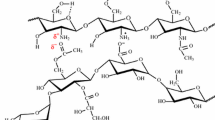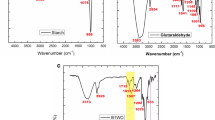Abstract
A controlled-release fertilizer made of biodegradable beads prepared with neat chitosan or chitosan/starch blends loaded with potassium nitrate was obtained using an ionic cross-linking process. This study looks at the influence of chitosan/starch mass ratio on the dynamic rheological behavior of the polymeric material without cross-linking. Every tested sample showed a viscoelastic behavior corresponding to entanglement networks of concentrated solutions except for the gelatinized starch that presented a gel behavior. Two factors affecting the water absorption and the fertilizer release were investigated: the polymeric composition (chitosan/starch mass ratio) and the cross-linking time. It was found that the equilibrium swelling degree decreased by increasing the beads’ starch content and/or the cross-linking time. When loaded beads were immersed 16 days in water under static conditions, the fertilizer release ratio was greater than 70% of the total loading. The hydrogel composition and the cross-linking time defined the mechanism governing the potassium nitrate release which was matrix relaxation controlled. Experimental results indicated that it is possible to modify the release profile of the loaded fertilizer which it is a very promising characteristic for the development of a compelling controlled-release fertilizer.





Similar content being viewed by others
References
Wu L, Liu M (2008) Preparation and properties of chitosan-coated NPK compound fertilizer with controlled-release and water-retention. Carbohydr Polym 72:240–247. https://doi.org/10.1016/j.carbpol.2007.08.020
Noppakundilograt S, Pheatcharat N, Kiatkamjornwong S (2015) Multilayer-coated NPK compound fertilizer hydrogel with controlled nutrient release and water absorbency. J Appl Polym Sci. https://doi.org/10.1002/app.41249
Perez JJ, Francois NJ (2016) Chitosan-starch beads prepared by ionotropic gelation as potential matrices for controlled release of fertilizers. Carbohydr Polym 148:134–142. https://doi.org/10.1016/j.carbpol.2016.04.054
Ahmed EM (2015) Hydrogel: preparation, characterization, and applications: a review. J Adv Res 6:105–121. https://doi.org/10.1016/j.jare.2013.07.006
Hoffman AS (2012) Hydrogels for biomedical applications. Adv Drug Deliv Rev 64:18–23. https://doi.org/10.1016/j.addr.2012.09.010
Flores-Céspedes F, Martínez-Domínguez GP, Villafranca-Sánchez M, Fernández-Pérez M (2015) Preparation and characterization of azadirachtin alginate-biosorbent based formulations: water release kinetics and photodegradation study. J Agric Food Chem 63:8391–8398. https://doi.org/10.1021/acs.jafc.5b03255
Lubkowski K, Smorowska A, Grzmil B, Kozłowska A (2015) Controlled-release fertilizer prepared using a biodegradable aliphatic copolyester of poly(butylene succinate) and dimerized fatty acid. J Agric Food Chem 63:2597–2605. https://doi.org/10.1021/acs.jafc.5b00518
Melaj MA, Daraio ME (2013) Preparation and characterization of potassium nitrate controlled-release fertilizers based on chitosan and xanthan layered tablets. J Appl Polym Sci 130:2422–2428. https://doi.org/10.1002/app.39452
Rashidzadeh A, Olad A, Salari D, Reyhanitabar A (2014) On the preparation and swelling properties of hydrogel nanocomposite based on Sodium alginate-g-Poly (acrylic acid-co-acrylamide)/Clinoptilolite and its application as slow release fertilizer. J Polym Res 21:344. https://doi.org/10.1007/s10965-013-0344-9
Liang R, Liu M, Wu L (2007) Controlled release NPK compound fertilizer with the function of water retention. React Funct Polym 67:769–779. https://doi.org/10.1016/j.reactfunctpolym.2006.12.007
Reddy N, Reddy R, Jiang Q (2015) Crosslinking biopolymers for biomedical applications. Trends Biotechnol 33:362–369. https://doi.org/10.1016/j.tibtech.2015.03.008
Zhou Z, Lin S, Yue T, Lee T-C (2014) Adsorption of food dyes from aqueous solution by glutaraldehyde cross-linked magnetic chitosan nanoparticles. J Food Eng 126:133–141. https://doi.org/10.1016/j.jfoodeng.2013.11.014
Bhattarai N, Gunn J, Zhang M (2010) Chitosan-based hydrogels for controlled, localized drug delivery. Adv Drug Deliv Rev 62:83–99. https://doi.org/10.1016/j.addr.2009.07.019
Berger J, Reist M, Mayer JM et al (2004) Structure and interactions in covalently and ionically crosslinked chitosan hydrogels for biomedical applications. Eur J Pharm Biopharm 57:19–34. https://doi.org/10.1016/S0939-6411(03)00161-9
Sahoo D, Sahoo S, Mohanty P et al (2009) Chitosan: a new versatile bio-polymer for various applications. Des Monomers Polym 12:377–404. https://doi.org/10.1163/138577209X12486896623418
Khoo C (2003) Oral gingival delivery systems from chitosan blends with hydrophilic polymers. Eur J Pharm Biopharm 55:47–56. https://doi.org/10.1016/S0939-6411(02)00155-8
Cascone MG, Barbani N, P.Giusti CC, et al (2001) Bioartificial polymeric materials based on polysaccharides. J Biomater Sci Polym Ed 12:267–281. https://doi.org/10.1163/156856201750180807
Ritger PL, Peppas NA (1987) A simple equation for description of solute release I. Fickian and non-fickian release from non-swellable devices in the form of slabs, spheres, cylinders or discs. J Control Release 5:23–36. https://doi.org/10.1016/0168-3659(87)90034-4
Peppas NA, Sahlin JJ (1989) A simple equation for the description of solute release. III. Coupling of diffusion and relaxation. Int J Pharm 57:169–172. https://doi.org/10.1016/0378-5173(89)90306-2
Nagahama H, Maeda H, Kashiki T et al (2009) Preparation and characterization of novel chitosan/gelatin membranes using chitosan hydrogel. Carbohydr Polym 76:255–260. https://doi.org/10.1016/j.carbpol.2008.10.015
Martínez A, Chornet E, Rodrigue D (2004) Steady-shear rheology of concentrated chitosan solutions. J Texture Stud 35:53–74. https://doi.org/10.1111/j.1745-4603.2004.tb00822.x
Serrero A, Trombotto S, Cassagnau P et al (2010) Polysaccharide gels based on chitosan and modified starch: structural characterization and linear viscoelastic behavior. Biomacromolecules 11:1534–1543. https://doi.org/10.1021/bm1001813
Horn MM, Martins VC, Plepis AM (2011) Effects of starch gelatinization and oxidation on the rheological behavior of chitosan/starch blends. Polym Int 60:920–923. https://doi.org/10.1002/pi.3021
Madsen F (1998) A rheological examination of the mucoadhesive/mucus interaction: the effect of mucoadhesive type and concentration. J Control Release 50:167–178. https://doi.org/10.1016/S0168-3659(97)00138-7
Mi F, Shyu S, Kuan C et al (1999) Chitosan—polyelectrolyte complexation for the preparation of gel beads and controlled release of anticancer drug. I. Effect of phosphorous polyelectrolyte complex and enzymatic hydrolysis of polymer. Polymer 74:1868–1879
Sacco P, Borgogna M, Travan A et al (2014) Polysaccharide-based networks from homogeneous chitosan-tripolyphosphate hydrogels: synthesis and characterization. Biomacromolecules 15:3396–3405. https://doi.org/10.1021/bm500909n
Xu YX, Kim KM, Hanna MA, Nag D (2005) Chitosan–starch composite film: preparation and characterization. Ind Crops Prod 21:185–192. https://doi.org/10.1016/j.indcrop.2004.03.002
Du C, Zhou J, Shaviv A (2006) Release characteristics of nutrients from polymer-coated compound controlled release fertilizers. J Polym Environ 14:223–230. https://doi.org/10.1007/s10924-006-0025-4
Singh N, Singh J, Kaur L et al (2003) Morphological, thermal and rheological properties of starches from different botanical sources. Food Chem 81:219–231. https://doi.org/10.1016/S0308-8146(02)00416-8
Jamnongkan T, Kaewpirom S (2010) Potassium release kinetics and water retention of controlled-release fertilizers based on chitosan hydrogels. J Polym Environ 18:413–421. https://doi.org/10.1007/s10924-010-0228-6
Melaj MA, Daraio ME, Vazquez A (2019) Controlled release on sand bed columns and biodegradability in soil of chitosan: hydroxypropyl methylcellulose films. J Appl Polym Sci. https://doi.org/10.1002/app.47532
Bajpai AK, Giri A (2002) Swelling dynamics of a macromolecular hydrophilic network and evaluation of its potential for controlled release of agrochemicals. React Funct Polym 53:125–141. https://doi.org/10.1016/S1381-5148(02)00168-2
Tomaszewska M, Jarosiewicz A (2002) Use of polysulfone in controlled-release NPK fertilizer formulations. J Agric Food Chem 50:4634–4639. https://doi.org/10.1021/jf0116808
Tomaszewska M, Jarosiewicz A (2004) Polysulfone coating with starch addition in CRF formulation. Desalination 163:247–252. https://doi.org/10.1016/S0011-9164(04)90196-8
Cong Z, Shi Y, Wang Y et al (2018) A novel controlled drug delivery system based on alginate hydrogel/chitosan micelle composites. Int J Biol Macromol 107:855–864. https://doi.org/10.1016/j.ijbiomac.2017.09.065
Xu J, Strandman S, Zhu JXX et al (2015) Genipin-crosslinked catechol-chitosan mucoadhesive hydrogels for buccal drug delivery. Biomaterials 37:395–404. https://doi.org/10.1016/j.biomaterials.2014.10.024
Zou X, Zhao X, Ye L (2015) Synthesis of cationic chitosan hydrogel and its controlled glucose-responsive drug release behavior. Chem Eng J 273:92–100. https://doi.org/10.1016/j.cej.2015.03.075
Wu YS, van Vliet LJ, Frijlink HW, van der Voort Maarschalk K (2006) The determination of relative path length as a measure for tortuosity in compacts using image analysis. Eur J Pharm Sci 28:433–440. https://doi.org/10.1016/j.ejps.2006.05.006
Acknowledgements
This work and the data herein contained were supported by Universidad de Buenos Aires, Argentina (Grant 20020170200078BA UBACyT 2018–2020). Thanks CONICET for fellowships.
Author information
Authors and Affiliations
Corresponding author
Additional information
Publisher's Note
Springer Nature remains neutral with regard to jurisdictional claims in published maps and institutional affiliations.
Rights and permissions
About this article
Cite this article
Perez Bravo, J.J., François, N.J. Chitosan/Starch Matrices Prepared by Ionotropic Gelation: Rheological Characterization, Swelling Behavior and Potassium Nitrate Release Kinetics. J Polym Environ 28, 2681–2690 (2020). https://doi.org/10.1007/s10924-020-01798-5
Published:
Issue Date:
DOI: https://doi.org/10.1007/s10924-020-01798-5




